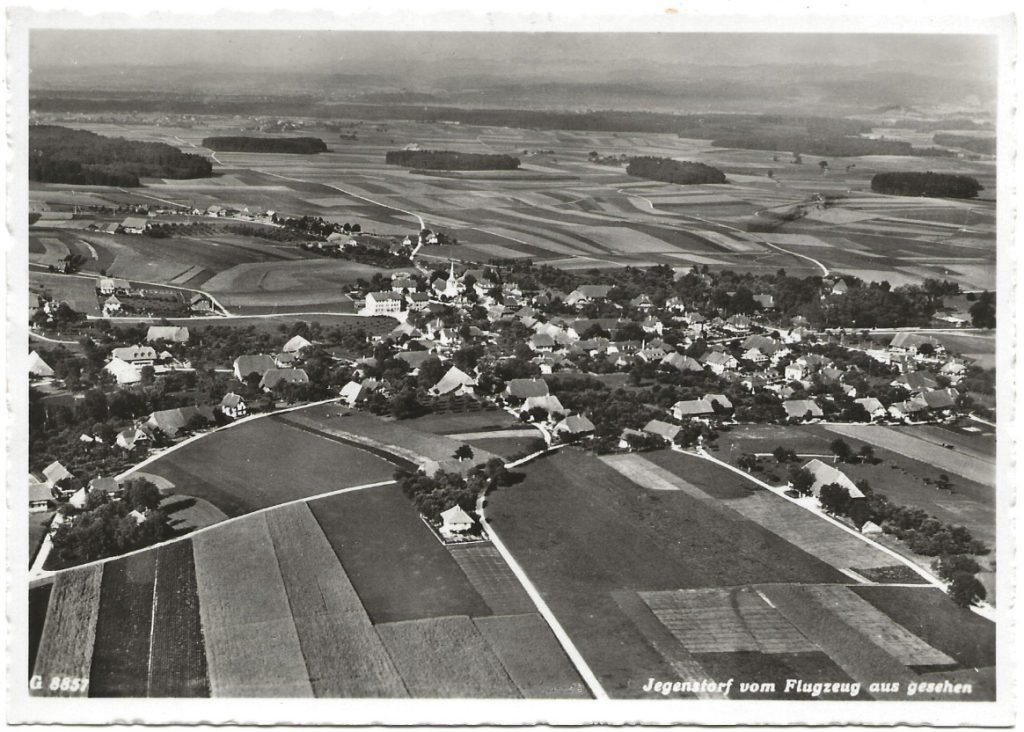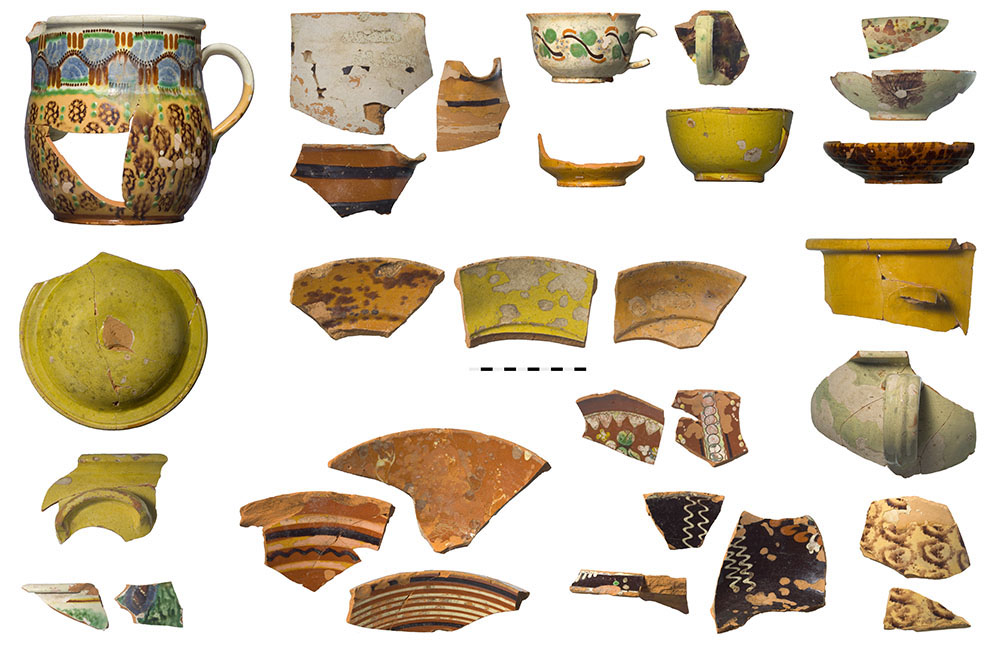
Jegenstorf as seen from the air, 1939, view towards the north-east.
Andreas Heege, Andreas Kistler, Alfred Spycher, 2025
While the only people with the surname Häberli prior to 1800 in the Bernese midlands were naturalised citizens of the municipalities of Krauchthal, Münchenbuchsee and Jegenstorf, there were many more in the Cantons of Lucerne, Thurgau and Zurich (Register of Swiss Surnames, online version). We have only partially succeeded in establishing a coherent and complete genealogy for the various potters called Häberli, as it was not possible to ascertain the links between some of the families. What we can say for now is that the genealogical investigations have not provided any evidence to show that the Häberli potters in 18th and 19th century Münchenbuchsee or Moosseedorf were in any way related to the Häberli potters from Hängelen. Nor were there any familial links between the latter and the Häberli potters that are known to have worked in Jegenstorf from 1861 to 1941; they can be shown to be part of the Häberli branch from Münchenbuchsee.
Häberli, Münchenbuchsee-Moosseedorf_genealogical data
Häberli, Münchenbuchsee-Jegenstorf, family tree
Jakob Häberli’s (1828-1877) father and grandfather were both schoolmasters from Münchenbuchsee and were both named Daniel (1750-1829 and 1787-1864 respectively). We have not been able to ascertain any familial links between them and the two lineages of Häberli potters from Münchenbuchsee. The potter Niklaus Häberli (1789-1858) from Münchenbuchsee was Jakob Häberli’s godfather (KRM_7_132, KRM = Münchenbuchsee church register). Jakob’s older sister Rosina (1813-1895) was married to potter Johann Jakob Häberli (1814-1874) from Münchenbuchsee. His older brother Niklaus (1824-1853) was a potter too and at the time of his death was working in Kiesen (perhaps as a journeyman?) (KRM_15_131; see also the death notice in: Intelligenzblatt für die Stadt Bern, 14th December 1853). It is not clear where Niklaus and Jakob learnt their craft. The records show that Jakob was issued with a journeyman’s book in 1847, which means that he probably did some travelling. On 22nd November 1851, he married Rosina Bürki from Muri (1829-?; KRThun_9_206) in Thun. The couple’s first five children were baptised in Bern and Münsingen respectively between 1852 and 1859 and the associated church records list the family’s place of residence as Münsingen, suggesting that Jakob Häberli was working there, either as a potter or a potter’s journeyman. Another six children were baptised between 1861 and 1873 in Jegenstorf, which was also registered as their place of residence. The location of Jakob’s workshop during this period is not known.

Berner Zeitung, Volume 23, Issue 229, 27th September 1867.
The records mention a Geldstag (a specifically Bernese type of liquidation process) for the year 1867, though information is scant on either the causes or consequences.
Jakob’s son, Johann Jakob Häberli (1858-1908), also trained as a potter. On 1st September 1882, he married Maria Junker from Jegenstorf (1859-1913) in Jegenstorf. The couple had five children (family tree). They probably rented the property of Niklaus Niklaus (1810-1879) at 12 General Guisanstrasse in Jegenstorf (“house and barn with adjacent residential building containing a potter’s workshop”; GBJ_04_325-328), or perhaps just the adjacent residential building and potter’s workshop, following the bankruptcy and death of Niklaus (for more information on the liquidation process see: Tagblatt der Stadt Biel, Volume 5, Issue 235, 4th October 1867).

Der Bund newspaper, Volume 47, Issue 51, 21st February 1896
Although the property was destroyed by fire in February 1896, the workshop was back up and running by 1898, as shown by an advertisement placed by Häberli in the Grütlianer newspaper seeking a thrower.

Grütlianer newspaper, 23rd April 1898.
On 13th October 1903, Johann Jakob purchased the entire property (GBJ_55_384-388). Following his death in 1908, his widow, Maria Häberli-Junker, handed over the potting property to her son, Johann Jakob Häberli (1885-1941) in 1910. When he died in 1941, the records pertaining to his estate listed him as “late master potter and farmer”. It is not clear when Johann Jakob gave up working as a potter to become a farmer. The house and potter’s workshop have since been demolished.
Unfortunately, there are no ceramics bearing the marks or signatures of the Jegenstorf Häberli potters and we do not know what their products looked like. However, 19th century finds from archaeological excavations carried out in recent years have painted an impressive picture of the kitchen- and tableware of Jegenstorf farming families at the time.

Jegenstorf, Kirchgasse, refuse pit 561, archaeological finds of everyday pottery dating from the period prior to c. 1890: milk jugs, cups, saucers, tureens, plates, dishes and chamber pots. Photos by Badri Redha, Archäologischer Dienst des Kantons Bern.
Surely, some of the pieces must have been made by the Häberli and Niklaus potters in Jegenstorf.
Translation Sandy Haemmerle

